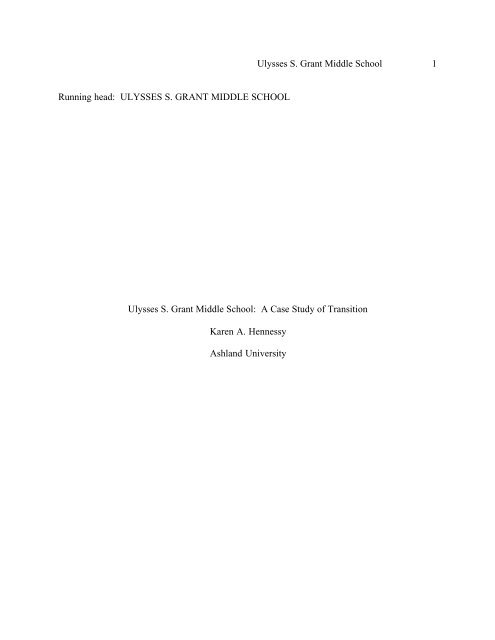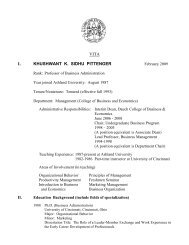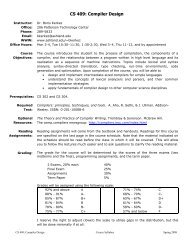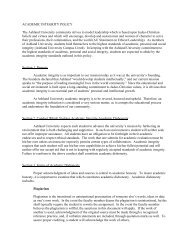Hennessy Paper - Ashland University
Hennessy Paper - Ashland University
Hennessy Paper - Ashland University
You also want an ePaper? Increase the reach of your titles
YUMPU automatically turns print PDFs into web optimized ePapers that Google loves.
Ulysses S. Grant Middle School 1<br />
Running head: ULYSSES S. GRANT MIDDLE SCHOOL<br />
Ulysses S. Grant Middle School: A Case Study of Transition<br />
Karen A. <strong>Hennessy</strong><br />
<strong>Ashland</strong> <strong>University</strong>
Ulysses S. Grant Middle School 2<br />
Abstract<br />
The acquisition of $76 million state tax dollars allowed Marion City Schools<br />
to renovate existing buildings and build additional schools. The existing three<br />
middle schools were combined into one large middle school, Ulysses S.<br />
Grant Middle School. A Transition Team was formed to research and report the<br />
most up-to-date middle school procedures. This case study examines some<br />
of the newest ideas in middle school practice to allow for the individual growth<br />
and development of all middle school students.
Ulysses S. Grant Middle School 3<br />
The florescent light shines onto the unscathed floor making it look wet and slippery. The<br />
blue border matches the bookcases, cupboards, and bulletin boards. The wipe-off board sits<br />
silently behind a package of unopened markers and an unsoiled eraser that has not yet been<br />
thrown in joy or in anger. My boxes are piled in a corner. The tape yielding to the summer heat<br />
is now weak and curling exposing the newest edition of the 6 th Grade Science Proficiency<br />
Workbook.<br />
The Long and Winding Road<br />
In November 1999, Dr. Robert Theide, who was then the Superintendent of Marion City<br />
Schools, breathed a sigh of relief. The bond issue of 4.19 mills he had proposed to the citizens of<br />
Marion City, a mid-size, mid-Ohio town with a population of approximately 36,000 (Marion<br />
City Schools [MSC] n.d.), had passed. And with this, the State of Ohio would give Marion City<br />
Schools $76 million state tax dollars. He knew this was an opportunity for Marion that should<br />
not be ignored, and he was relieved that it was not.<br />
When it all started, it was not surprising, in this rather conservative town, for many<br />
people to wonder, “What’s the catch” And to their relief they found out quickly that there was<br />
no catch. The $76 million was part of a $500 million fund set aside by the State of Ohio to<br />
finance approximately 20-30 low wealth school districts across the state. Marion City Schools<br />
would work in partnership with the Ohio Schools Facilities Commission using the State’s Master<br />
Design Manual for specifications and requirements for renovations to existing buildings along<br />
with the brand new buildings (MCS, n.d.).
Ulysses S. Grant Middle School 4<br />
The new buildings included a new high school, the expansion of the high school building<br />
to accommodate the merging of the three middle schools into one, and three new elementary<br />
buildings. The “renovations” were not merely new chalkboards and coat racks, but air<br />
conditioning, science labs, computer labs, and larger classrooms. The buildings would also have<br />
security as a priority providing modern alarm systems, cameras throughout the building, fire<br />
sprinkler systems, and a more efficient heating system (MCS, n.d.). These were all things the<br />
buildings had needed for years.<br />
Middle of the Road<br />
Ulysses S. Grant Middle School would be the compilation of the three previously existing<br />
middle schools in Marion City: Baker Middle School, Edison Middle School, and Taft Middle<br />
School. How would this happen amicably as each were diverse and even competitive and had<br />
been for many years How would the staff from these three buildings work in harmony after<br />
many of them had been together at the same middle school, or on the same team for 10 or even<br />
15 years Could the students from opposite sides of town find enough common ground to get<br />
through a school day or even become friends The future was as frightening as it was exciting<br />
for everyone involved, students, parents, and teachers alike.
Table 1<br />
The Facts<br />
Ulysses S. Grant Middle School 5<br />
2002-2003<br />
Enrollment White, non-Hispanic Black, Non-Hispanic Gifted Disabled Economic Disadvantage<br />
Baker 499 89.40% 8.00% 16.30% 15.50% 22.90%<br />
Edison 364 92.10% 3.90% 10.50% 19.70% 53.40%<br />
Taft 425 83.30% 12.80% 8.10% 18.70% 57.20%<br />
Department of Education, 2003-2004 District Grade Cards<br />
Based on the above statistics (Table 1) from the Ohio Department of Education, one can<br />
see the diversity between the middle schools, especially in the areas of race, giftedness, and<br />
economically disadvantaged students. Many teachers know that traditionally test scores are<br />
higher when income is higher (Trimble, 2002). While it is not fact, many teachers believe that<br />
behavior is a problem when income is a problem. Some of the teachers that would be taking on<br />
more economically disadvantaged students because of the transition were worried. Other<br />
teachers worried that the gifted students from the more affluent part of the city might be arrogant<br />
and spoiled hence also a problem. “Always present is the human inclination to resist change.”<br />
(Lounsbury and Vars, 2003, p.3) Teachers are no exception.<br />
The Middle School Transition Team<br />
Smith-Maddox (1999) said, “Dialogue is the single factor which seems to have the<br />
greatest power to assess our knowledge and carry forward our understanding of the teacher’s role<br />
in implementing the ideas of reform and proposed innovations.” (p. 286) Marion City School<br />
District agreed and developed The Middle School Transition Team in June of 2000. This team<br />
included three Administration Staff members and five staff members from each of the three<br />
middle schools (Marion City Schools [MCS], 2000). Because shared decision-making is an
Ulysses S. Grant Middle School 6<br />
important element in successful schools, this team would examine every aspect from every angle<br />
of the future U.S. Grant Middle School (Calderwood, 1999).<br />
It has been 19 years since the 6-8 middle school became the most common form of<br />
school organization in the United States. While this sounds like a lengthy run, one must not<br />
forget that the first Junior High school to ever exist was formed nearly 100 years ago<br />
(Lounsbury & Vars, 2003). To find the most up-to-date theories and practices to make U.S.<br />
Grant Middle School a state-of-the-art middle school the Transition Team did their homework.<br />
The Transition Team poured over the latest middle school research and sought the<br />
expertise of the staff at the National Middle School Association including Dr. John Swain, an<br />
educational consultant for middle grades education and a faculty member at Otterbein<br />
<strong>University</strong>. The Team traveled to other schools in central Ohio, which had also experienced<br />
renovations or expansions to learn about building designs and facilities management. They<br />
talked to countless principals and teachers who had experienced mergers and transitions. The<br />
Transition Team developed in-service opportunities for the middle school staff and teachers to<br />
address their concerns and relay information they had gathered (MCS, 2000). Many times, it<br />
was a thankless job, yet one necessary to insure communication and calm the nerves of parents,<br />
teachers, and students that would live this transition in the coming months.<br />
Smaller as Better<br />
The National Forum to Accelerate Middle-Grades Reform is a group of education<br />
associations, foundations, practitioners, and researchers working to improve middle grade<br />
education. One of their recommendations for a successful school includes small, learning<br />
communities (Kasak, 2004). These small learning communities provide students with more
Ulysses S. Grant Middle School 7<br />
opportunities to participate in activities and have a sense that they “belong” (Cotton, 1996).<br />
Small schools also allow greater attention to problems and success of all students<br />
(Gisolfi, 1999). This ‘school within a school’ theory also allows students to know who their<br />
teachers will be in the coming years (George & Lounsbury, 2000). Smaller schools are better for<br />
teachers and parents as well as students. In a smaller learning community teachers often have a<br />
better attitude toward their work and their administrators (Moriarty, 2002). Smaller learning<br />
communities also offer the benefits of both protection and outreach which are both important<br />
concepts in middle schools so that the students are “guided” rather than “thrown” through the<br />
system (Gisolfi, 1999). Jackson and Davis (2000) claim in Turning Points 2000 that dividing<br />
large populations of students into smaller groups “is perhaps the most exciting development of<br />
the past decade in the organization of middle schools.” (p. 125) Year after year, public opinion<br />
recognizes that class size can make or break achievement in a school (Weaver, 2004).<br />
Grant Middle School will have approximately 1300 students. The Transition Team<br />
proposed that students be divided heterogeneously into four separate houses. Each house would<br />
act as a smaller school. Each house would have a principal, secretary, sixth grade team, seventh<br />
grade team, and eighth grade team. Once a student was assigned to a specific house they would<br />
stay with that house throughout their time at Grant Middle School. To ensure a heterogeneous<br />
group the Transition Team proposed that no requests or changes be made for specific houses,<br />
teams or teachers. The Transition Team made this suggestion for the teachers also (Marion City<br />
Schools Middle School Transition Team Proposal Summer 2001 Draft, [Draft], 2001).
Ulysses S. Grant Middle School 8<br />
Teaming<br />
Among many other things, Jackson and Davis (2000) claim teaching teams “provide a<br />
psychological home within the school that helps reduce the stress of isolation and anonymity.”<br />
(p. 125) Teams provide middle grade students with additional teacher attention (Jackson and<br />
Davis, 2000), and a sense to students that they are “an important part of an important group.”<br />
(George and Lounsbury, 2000, p. 14) Teaming also helps teachers develop, implement and<br />
monitor educational goals for their students (Rottier, 2000).<br />
As many teachers know, teaming is a process that takes time and patience to develop.<br />
There are stages that teams experience which begin with “teaming in name only” and progress<br />
toward full curriculum integration. In-between newly formed teams and long established teams<br />
there are a variety of issues. Successful teams function as teams, not as a group of individuals<br />
working in close proximity. Teams are not several teachers that share space, time, and students<br />
(Mizell, 2000), but share a mindset of ideas to best educate middle school students by increasing<br />
learning opportunities (Trimble, 2002).<br />
The teachers at Grant Middle School will be a collection of teachers from all three middle<br />
schools intertwined into fresh teams. The Transition Team proposed that teams have common<br />
instructional planning time, rules, procedures and space in the new building (Draft, 2001).<br />
Through creative scheduling, they will be able to interact with their colleagues to cultivate<br />
curriculum integration and build a sense of community (NMSA, 1995). They will have time<br />
together to coordinate activities, and to “select ideas for in-depth study from a vast range of<br />
information and materials that are genuinely important and worth knowing.” (NMSA, 1995,
Ulysses S. Grant Middle School 9<br />
p.21) Since all of the teachers will be members of new teams, they will have work to do in<br />
establishing trust between each other, and a commitment to student needs.<br />
Curriculum and Instruction<br />
While curriculum for 6 th , 7 th, and 8 th graders in Ohio is, for the most part, predetermined<br />
by the State Department of Education, instruction is still the heart of every teacher. Instruction is<br />
not only what we do, it determines what kind of teacher we are, how we interact with students, if<br />
we love our job and if students remember us long after we’re gone. Instruction is the reason why<br />
many of us chose teaching as our career in the first place.<br />
The Transition Team proposed that instruction be authentic (Draft, 2001). If students<br />
don’t value the information or are unable to apply it to their life, it will have little real meaning to<br />
them and consequently, their efforts will be minimal. The way we instruct is “only limited by<br />
our imaginations.” (Clark, 2004, p. 4) Student-centered instruction, instruction that allows<br />
students to explore, discuss, and decide create opportunities for all willing students to succeed.<br />
Project options which allow students to develop their own way to display their knowledge gives<br />
students choices in their learning which allows them to become more vested in their own<br />
education (VanHoose, Strahan & L’Esperance, 2001).<br />
Technology will compliment instruction at Grant Middle School. New computers have<br />
been added in an expanded Technology room and in-class computers will be available in all 6 th<br />
grade rooms. The district began using an on-line attendance, grade book, and lesson plan<br />
program last year. At the beginning of the 2004-2005 school year it will be mandatory for all<br />
teachers to use the new system. The district has provided teaches with continued support and
Ulysses S. Grant Middle School 10<br />
instruction throughout the school year. They have offered teacher in-service courses and teacher<br />
incentives to attend additional computer training.<br />
Developmental Needs of Adolescents<br />
The physical and emotional changes that characterize children ages 10-14 are as varied as<br />
the children themselves. Physically, growth does not occur evenly and emotionally, students are<br />
controlled by “dramatic changes in self-concept.” (VanHoose, Strahan & L’Esperance, 2001, p.<br />
47) Secrets are a valuable ingredient in helping to create an adolescent’s identity (Perlstein,<br />
2003). Teachers are also an important part of this developmental process. Teachers must show<br />
students that we believe in them and continually remind them that they possess unique talents<br />
and abilities (Clarke, 2004).<br />
The relationship between students and teachers is also important to teachers, ranking<br />
highest overall in terms of professional importance and satisfaction (Shann, 1998). We must<br />
serve as role models to our students and be willing and able to continually trust students are<br />
doing their very best (NMSA, 1995). Despite what we may believe in April, our students are not<br />
lying awake at night trying to figure out ways to disappoint us.<br />
Advocacy programs are an excellent way to nurture long-term student-teacher<br />
relationships (Draft, 2001). Caring adults can enhance a sense of security; provide guidance and<br />
encouragement and individual growth for middle grade students (VanHoose, Strahan &<br />
L’Esperance, 2001). Grant Middle School will employ an advisory program within each house<br />
to assure that every student will be well known by at least one adult (Jackson and Davis, 2000).
Ulysses S. Grant Middle School 11<br />
Dr. Santo Pino<br />
The Middle School Transition Team was also responsible for helping search and<br />
interview for a Director to Grant Middle School. They suggested that the Director be responsible<br />
for public relations, report to the Superintendent and assist teachers and principals in curriculum<br />
and instruction whenever necessary (Draft, 2001). In September of 2002, Marion City Schools<br />
Board of Education hired Dr. Santo Pino as the Executive Director of Middle Level Programs.<br />
Dr. Pino has spent nearly 40 years in education. He has served as National Middle<br />
School Association President and the Co-Executive Director of the Florida League of Middle<br />
Schools. Dr. Pino also helped design the educational program for Manatee Education Center in<br />
Naples, Florida, which was recognized by the state of Florida, and the U.S. Department of<br />
Education. Dr. Pino is a leader in middle school theory and practice and has presented on middle<br />
level education and leadership at state and national conferences (Personal communication, June<br />
2004).<br />
Dr. Pino spent countless hours educating the staff, teachers, students, and parents about<br />
the middle school transition. He held open forum meetings with numerous parents at numerous<br />
schools to address students, their parents, business leaders, and interested members of the<br />
community. He is the first to admit that change is never easy, but it is possible if everyone<br />
involved remains flexible.<br />
In just a few weeks I’ll arrive at my new classroom in Ulysses S. Grant anxious to unpack<br />
the boxes, put up posters and make the room my own. I’m no different than any other teacher at
Ulysses S. Grant Middle School 12<br />
Grant Middle School who has been with Marion City Schools middle school for the last three<br />
years. For some teachers it has been painfully frustrating. For others it has been full of<br />
anticipation and excitement. Despite which side of the fence one stands, it has been an<br />
opportunity few teachers have the chance to experience. Many years from now it will continue<br />
to highlight my professional teaching career.
Ulysses S. Grant Middle School 13<br />
References<br />
Calderwood, P.E. (1999). The decision dance: Staff decision making in a restructuring urban<br />
middle school. The Urban Review, 31(4), 385-417.<br />
Clark, R. (2004). The power of the positive: Four rules for success. The Magazine of Middle<br />
Level Education, 7(4)[Electronic version]. Retrieved June 21, 2004.<br />
http://www.nmsa.org/services/middle_ground/mg_april04.htm<br />
Cotton, K. (1996). School size, school climate, and student performance. [Electronic version].<br />
SchoolImprovement Series. Retrieved June 20, 2004, from<br />
http://www.nwrel.org/scpd/sirs/10/c020.html<br />
Department of Education District Report Cards. Retrieved June 20, 2004, available from<br />
http://ilrc.ode.state.oh.us/Default.asp<br />
George, P.S. & Lounsbury, J.H. (2000). Making big schools feel small: Multiage grouping,<br />
looping, and schools-within-a-school. Columbus, OH: National Middle School<br />
Association.<br />
Gisolfi, P.A. (1999). A sum of its parts. American School & <strong>University</strong>, 99(5), 29-31.<br />
Jackson, A.W., & Davis, G.A. (2000). Turning points 2000: Education adolescents in the 21 st<br />
century. New York: Teacher’s College Press.<br />
Kasak, D. (2004). What middle grades need. American School Board Journal. 191(5), 44-45.<br />
Lounsbury, J.H., Vars, G.F. (2003). The future of middle school education: Optimistic and<br />
pessimistic views. [Electronic version]. Middle School Journal, 35(2).<br />
http:www.nmsa.org/services/msj/msj_november2003.htm
Ulysses S. Grant Middle School 14<br />
Marion City Schools (n.d.), Retrieved June 20, 2004.<br />
http://www.marioncityschools.org/building/update.htm<br />
Marion city schools middle school transition team newsletter. (2000, Oct. 30). Marion City<br />
Middle Schools Transition Team.<br />
Marion City Schools Middle School Transition Team Proposal Summer 2001 Draft, [Draft],<br />
2001.<br />
Mizell, H. (2000, March 23). Middle school reform: Where are we now <strong>Paper</strong> presented at The<br />
William Winter Principals Leadership Institute. Abstract retrieved June 18, 2004, from<br />
http://www.middleweb.com/HMFndMidS.html<br />
Moriarty, A.M. (2002, August 7). Just right, School size matters. The Washington Post.<br />
Retrieved June 18, 2004 from http://www.washingtonpost.com/ac2/wp-dyn/A48365-<br />
2002Aug6language=printer<br />
National Middle School Association. (1995). This we believe: Developmentally responsive<br />
middle level schools. Columbus, OH: Author.<br />
Perlstein, L. (2003, October 20). Surviving middle school. People, 60, 60.<br />
Rottier, J. (2002). Teaming in the middle school: Improve it or lose it. Clearing House, 73(4),<br />
214-216.<br />
Shann, M.H. (1998). Professional commitment and satisfaction among teachers in urban middle<br />
schools. Journal of Educational Research, 92(2), 67-73.<br />
Smith-Maddox, R. (1999). An inquiry-based reform effort: Creating the conditions for<br />
reculturing and restructuring schools. Los Angles, CA: Human Sciences Press, Inc.
Ulysses S. Grant Middle School 15<br />
Trimble, S. (2002). Common elements of high performing, high poverty middle schools.<br />
Columbus, OH: National Middle School Association.<br />
Van Hoose, J., Strahan, D. & L’Esperance, M. (2001). Promoting harmony: Young adolescent<br />
development and school practices. Columbus, OH: National Middle School Association.<br />
Weaver, R. Solution isn’t that simple. (2004, June 28). USA Today, p. 10a.<br />
The 2004-2005 school year will be Karen <strong>Hennessy</strong>’s sixth year teaching sixth grade<br />
Science for Marion City Schools, Marion, Ohio. She looks forward to the grand opening of the<br />
new Ulysses S. Grant Middle School.
















